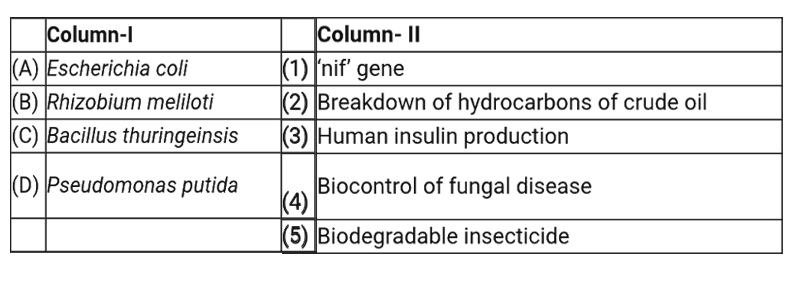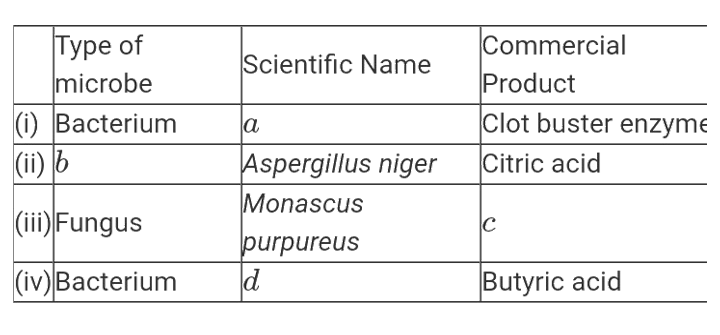Consider the table given below
Which one of the following option, gives the correct fill ups for the respective blank (A to C)
(1)
A–Wheat, B–Pusa Shubhra, C–Boll worms
(2)
A–Brassica, B–Pusa Sem-3, C–Fruit borer
(3)
A–Wheat, B–Pusa Komal, C–Boll worms
(4)
A–Brassica, B–Pusa A-4, C–Shoot bore
The correct Answer is:D
To solve the question, we need to fill in the blanks A, B, and C in the table based on the given information about crops, their varieties, and the associated insect pests. Here's a step-by-step breakdown of the solution:
Step 1: Analyze the Given Information
The table provides:
- Crop: Unknown for A and B, Okra for C
- Variety: Pusa Gaurav for A, Unknown for B, Pusa Sawani for C
- Insect Pests: Aphids for A, Jassids for B, Unknown for C
Step 2: Identify the Crop for A
From the video transcript, we learn that:
- Pusa Gaurav is associated with Brassica and the insect pest is Aphids.
Thus, we can fill:
- A = Brassica
Step 3: Identify the Variety for B
The crop for B is Flat Bean, and the insect pest is Jassids. According to the transcript:
- The variety produced for Flat Bean against Jassids is Pusa Sem-3.
Thus, we can fill:
- B = Pusa Sem-3
Step 4: Identify the Insect Pest for C
For C, we have Okra and the variety Pusa Sawani. The transcript indicates that the insect pest affecting Okra is:
- Fruit Borer.
Thus, we can fill:
- C = Fruit Borer
Step 5: Compile the Answers
Now we can summarize the filled table:
- A: Brassica
- B: Pusa Sem-3
- C: Fruit Borer
Step 6: Match with Options
Now we need to check which option matches our findings:
1. A–Wheat, B–Pusa Shubhra, C–Boll worms (Incorrect)
2. A–Brassica, B–Pusa Sem-3, C–Fruit borer (Correct)
3. A–Wheat, B–Pusa Komal, C–Boll worms (Incorrect)
4. A–Brassica, B–Pusa A-4, C–Shoot borer (Incorrect)
The correct option is (2) A–Brassica, B–Pusa Sem-3, C–Fruit borer.
The table provides:
- Crop: Unknown for A and B, Okra for C
- Variety: Pusa Gaurav for A, Unknown for B, Pusa Sawani for C
- Insect Pests: Aphids for A, Jassids for B, Unknown for C
From the video transcript, we learn that:
- Pusa Gaurav is associated with Brassica and the insect pest is Aphids.
Thus, we can fill:
- A = Brassica
The crop for B is Flat Bean, and the insect pest is Jassids. According to the transcript:
- The variety produced for Flat Bean against Jassids is Pusa Sem-3.
Thus, we can fill:
- B = Pusa Sem-3
For C, we have Okra and the variety Pusa Sawani. The transcript indicates that the insect pest affecting Okra is:
- Fruit Borer.
Thus, we can fill:
- C = Fruit Borer
Now we can summarize the filled table:
- A: Brassica
- B: Pusa Sem-3
- C: Fruit Borer
Now we need to check which option matches our findings:
1. A–Wheat, B–Pusa Shubhra, C–Boll worms (Incorrect)
2. A–Brassica, B–Pusa Sem-3, C–Fruit borer (Correct)
3. A–Wheat, B–Pusa Komal, C–Boll worms (Incorrect)
4. A–Brassica, B–Pusa A-4, C–Shoot borer (Incorrect)
Topper's Solved these Questions
- BIOLOGY IN HUMAN WELFARE (DOMESTICATION OF PLANTS & ANIMALS) BOOK - ALLENCHAPTER - BIOLOGY IN HUMAN WELFARE (DOMESTICATION OF PLANTS & ANIMALS) EXERCISE - Exercise-II (Previous Year Questions)
32 Videos
- BIOLOGY IN HUMAN WELFARE (DOMESTICATION OF PLANTS & ANIMALS) BOOK - ALLENCHAPTER - BIOLOGY IN HUMAN WELFARE (DOMESTICATION OF PLANTS & ANIMALS) EXERCISE - Exercise-III (Assertion & Reason)
12 Videos
- BIOLOGY AT A GLANCE (ZOOLOGY )BOOK - ALLENCHAPTER - BIOLOGY AT A GLANCE (ZOOLOGY )EXERCISE - EXERCISE
207 Videos
- BIOLOGY IN HUMAN WELFARE (HEALTH & DISEASES) BOOK - ALLENCHAPTER - BIOLOGY IN HUMAN WELFARE (HEALTH & DISEASES) EXERCISE - Exercise -IV Assertion : Reason
20 Videos
Similar Questions
Knowledge Check
Consider the following statements (A-C) each with one or two blanks.
(A) (1)––– are the most abundant cells (60-65%) of the total WBCs and (2)––– are the least (0.5-1%) among them.
(B) Platelets are cell fragments produced from (3)–––
(C) During clot formation, fibrins are formed by the conversion of inactive (4)––– in the plasma by the enzyme (5)–––
Which one of the following options, gives the correct fill ups for the respective blank numbers from (1) to (5) in the statements ?A(1)-Neutrophils, (2)-basophils, (4)-fibrinogens, (5)-thrombinB(3)-mast cells, (4)-thrombokinase, (5)-prothrombinC(3)-megakaryocytes, (4)-prothrombin, (5)-thrombinD(1)-Basophils, (2)-neutrophils, (3)-reticulocytesWhich of the following is equivalent to (2b3c2+b2c)−(b3c2−b2c−4bc)?
A0Bb3c2Cb3c2+2b2cDb3c2+2b2c−8bc
Identify 'A','B','C' and 'D' in the given table .
CropvarietyResistance to diseaseAHimgiriLeaf rustCauliflower Pusa shubhrab BrassicaPusa Swarnim CCowpeaDBecterial blight
View SolutionMatch the following and choose the correct combination from the options given :

(a) ABCD3154
(b) ABCD1234
(c) ABCD2134
(d) ABCD3152
View SolutionIf A∩B⊆C and A∩B≠ϕ. Then which of the following is incorrect (1) (A∪B)∩C ≠ϕ (2) B∩C=ϕ (3) A∩C≠ϕ (4) If (A−B)⊆C, then A⊆C
View SolutionMatch column with column II and select the correct option from
codes given below.
Column IColumn IIA. Brassica(i) HmigiriB. Okra(ii) Pusa KomalC. Wheat(iii) Pusa GauravD. Cowpea(iv) Pusa Sawani
View SolutionMatch the columns I and II, and choose the correct combination from the options given.
Column IColumn IIa. Brassica1. Pusa Sawanib.Cauliflower2.Pusa Sadabaharc.Chilli3. Pusa Shubhrad. Okra4. Pusa Swarnim
View SolutionMatch column I with column II , choose the answer Which given the correct combination of the alphabets of the two columns
column l column ll A. wheat p. pusa komal B.chilli q.himgiri C.cauliflower r.pusa sadabahar D.cowpea s.pusa shubra
View Solution

